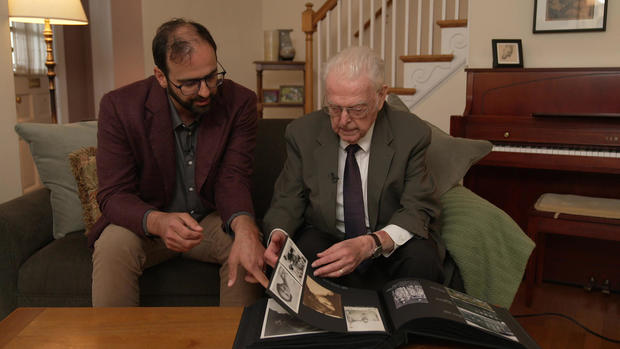Re-creating the taste of a childhood lost in the Holocaust
Amidst the rich culinary landscape of New Orleans is a restaurant named Saba, which means grandfather in Hebrew. Its owner, Israeli chef Alon Shaya, has been winning awards for his modern Middle Eastern cuisine, which is odd given that, when he first emigrated from Israel at the age of four, his roots were something he’d hoped to erase. “I spent so much of my life trying to hide my Israeli identity,” Shaya said, recalling, “At the age of four and five years old, the last thing you want to do is talk to them about this chickpea fritter that you’re bringing to school, when they’re eating tater tots.”
In culinary school, instead of hummus and pita, Shaya went full Italian; his passions were pastas, charcuterie and pizzas. Until, that is, in his mid-30’s when, on a trip back to Israel, the dishes of his youth whispered anew. “I realized that I was really missing out on a part of who I was,” he said. He started cooking Israeli food again. And that, he said, was when he “really began understanding what my identity was as a chef.”
Ever since, he’s been marinating in Israeli ingredients, and their history, which one day brought him to perhaps an unlikely place for a chef: the archives of the United States Holocaust Memorial Museum. He was both heartened and disturbed to learn that during the Holocaust, those forced into Jewish ghettos and concentration camps would write down family recipes, not to cook, but to remember. “I was just blown away by how, during one of the most horrible moments in someone’s life, that they could turn to food, and that food would have that power,” he said.
United States Holocaust Memorial Museum
Steven Fenves was 13 when his train arrived at Auschwitz in 1944. Memories of food, he said, would remind inmates of home: “It reminded you of pleasure in this lousy place where you were not a human,” he said.
All the tangible evidence of Fenves’ life before had been ripped away, or so he thought. To his surprise, after he and his sister were liberated from Auschwitz, his mother’s recipe book appeared.
CBS News
Steven Fenves’ family had lived an upper-middle-class life in the former Yugoslavia. They employed a maid, a chauffeur, a governess, and a cook named Maris. “Big woman! Very thick Hungarian accent,” said Steven.
On the day looters stormed into his home as his family were being sent off – presumably to the gas chambers – Maris, who wasn’t Jewish, raced in to save the family cookbook for reasons Steven still doesn’t totally understand. “I think it was a sense of loyalty, and a sense of love for the family,” he said. It was, he admitted, a pretty brave thing for Maris to do, when the risk to her was punishment by death.
United States Holocaust Memorial Museum
When Shaya discovered the book in the basement of the Holocaust Museum’s collection, he had one question: Could he actually talk to someone who remembers eating this food? “And they said, ‘Yeah, maybe we can put you guys in touch,'” he said.
When Shaya heard Steven’s story, he was so moved that he set about re-creating the taste of his childhood.
CBS News
The recipes had to be adapted: “The recipes in this book aren’t written like recipes like you would see in a cookbook today,” he said.
Cowan asked, “So, it’s not like, a half a teaspoon of this?”
“No, no. Imagine your grandmother teaching you how to make a dish, you know, a little bit of this, a little bit of that,” Shaya replied.
Fenves said, “Essentially, you know, there were no heat setting instructions, because this was all done on a cast iron stove.”
“I don’t have that setting on my stove!” Shaya laughed.
There were potato circles, a walnut cream cake, and semolina sticks.
CBS News
Fenves began translating the recipes from Hungarian into English, and Shaya began cooking the food and shipping the food to Fenves to taste for the first time in more than 70 years.
Steven’s whole family got involved, and in the process Fenves rediscovered a painful personal connection to his story that he says had gotten lost over the years. “It had become such a chore,” he said, when bearing witness to the horrors of the Holocaust. “I no longer broke into tears in my presentation. It just became so routine, so cold.”
But somehow Shaya’s revival of his mother’s cooking reminded him of all that was lost. “Frankly speaking, he got me out of a major slump in my duty to speak as a volunteer survivor,” Fenves said.
“How did he get you out of your slump?” asked Cowan.
“He made it new; he made it interesting, and made it moving. … The effect of it on me was very pronounced. I mean, childhood food? It seemed to have been something tangential that went by the way with lots of other things that went by the way.”
Together, these newfound friends now host donor dinners where his mother’s dishes are served, and Fenves speaks. So far, they’ve raised more than $300,000 for Holocaust conservation efforts.
Passover is about the imperative to remember, both the good and the bad. Alon Shaya offered that gift through food, and because of it, Steven Fenves has a renewed mission to tell the terrible tale that must be told.
CBS News
RECIPE: Semolina Sticks
For more info:
Story produced by Sara Kugel. Editor: Ed Givnish.
For all the latest Automobiles News Click Here
For the latest news and updates, follow us on Google News.







